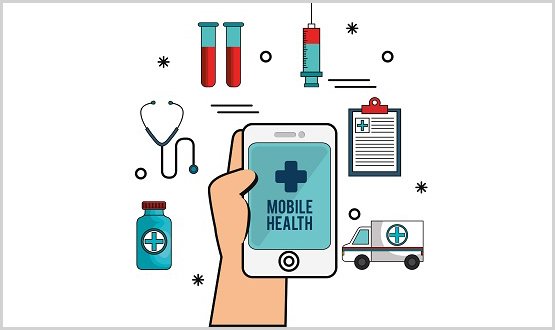Overcoming the barriers to greater use of mobile technology in healthcare
- 19 January 2018

For many of us, the idea of navigating daily life without a smartphone or tablet computer has become unthinkable. And yet, while on the up, such technology has not yet achieved ubiquitous status in healthcare settings. Claire Read reports on new Digital Health Intelligence research exploring why that is, and how barriers to greater use of mobile technology in healthcare might be overcome.
You’re walking down the street and spy someone coming towards you, but it’s very clear they haven’t spied you. Their eyes are cast downwards, at a shiny rectangular object in their hand. And they can’t even hear your footsteps, what with the music blaring from the distinctive white earbuds dangling from their ears.
If it feels like the vast majority of the people you encounter are obsessed with their phone, then that’s because they probably are. According to research by UK telecommunications regular Ofcom, three quarters of UK adults now own a smartphone, and almost 60% have a tablet computer. And that near-ubiquity of mobile devices is, undoubtedly, impacting healthcare.
Upwardly mobile
In recent years, Digital Health has reported extensively on the growth of healthcare apps targeted directly at patients or the general public more broadly. And with software like e-observations systems – through which nurses enter vital signs data onto a mobile device rather than paper – or with systems that allow community nurses to access records electronically, the impact is being felt in healthcare itself.
It is equally clear, however, that there are barriers to fuller uptake of mobile technology in the care sector. A common – and understandable – refrain is that the NHS has not yet been transformed by mobile devices and connectivity to the same extent as other areas. Indeed, one global digital exemplar is expressly stating its aim is to use technology to become more like easyJet.
Clear benefits
So just what are the opportunities presented by greater use of mobile devices in healthcare? And what are the barriers preventing those opportunities from being seized?
Those are the questions at the heart of a new Digital Health Intelligence report, published today in association with Samsung. “Upwardly mobile: the rise of mobile working in healthcare – exploring the benefits, the barriers and the opportunities” – is based on a survey of 116 healthcare IT leaders from across health and social care, and in-depth interviews with nine leading chief clinical information officers (CCIOs) and chief information officers (CIOs).
It leaves little doubt that there are very real benefits already being realised through the use of mobile technology in healthcare settings. For instance, 96% of those surveyed for the report said they saw “increased benefits” from working remotely. And, clearly, in many instances that remote working is going to be made possible by mobile technology.
Increased productivity
Meanwhile, the CIOs and CCIOs we interviewed spoke of mobile devices and apps being important in increasing productivity. Dr Afzal Chaudhry, CCIO at Cambridge University Hospitals NHS Foundation Trust, reported that ward use of mobile devices with an app linked to an electronic patient record (EPR) had significantly increased efficiency at the organisation.
“We reckon that the use of that mobile app trust-wide saves us somewhere between 35 and 40 whole time nursing equivalents a year, in terms of time that they used to waste either charting information or looking for pieces of information, because it’s now either available to hand or they can enter it in real time.”
Spotting sepsis
Apps which deliver patient safety benefits were frequently mentioned. At Royal Liverpool and Broadgreen University Hospitals NHS Trust, mobile devices are being used to support the identification of sepsis – which currently claims more UK lives than prostate cancer, breast cancer and bowel cancer put together.
“With the algorithm that we use for electronic sepsis reporting, we estimate that 200 lives a year will be saved by identifying the sepsis indicators quicker,” said David Walliker, the trust’s chief information officer.
A similar setup is in place at Chelsea and Westminster NHS Foundation Trust, and similar benefits have been seen. The clinical director of acute services at the organisation anticipates that just on one of its hospital sites, 50-60 lives a year should be saved through better identification of sepsis via mobile devices.
It’s the money… and more
The natural question, then: why aren’t mobile devices a part of the kit of every single NHS worker up and down the country? Predictably the other ‘m’ word came up in our research – money. But those we interviewed suggested the barriers go beyond that, and to complex cultural issues.
Royal Liverpool and Broadgreen’s Walliker suggested mobile devices and clinical software can bring users the immediate impression that they are being constantly assessed. “I think there is a sociological piece that you need to [solve] in that [as a member of staff using trust mobile apps] big brother is effectively watching you all the time.”
For Joanna Smith, CIO at Royal Brompton & Harefield NHS Foundation Trust, there was also an issue of how using mobile devices at work was perceived by staff. “I hear from some of the nurse educators that they actually do not allow nurses to be using their mobile phone when on the wards because they are there to care for patients. They do not want patients to think the nurses are more interested in social media. So that was a big surprise to me.”
She added: “Some of our nurses don’t even like the idea of using mobile devices to put information into clinical systems. They just want to be interacting with the patient. Of course, that can be overcome. We can help them understand how they’re reducing risk for the patient, [and how] they’re going to catch issues quicker.”
Co-production and bolstering infrastructure
Enter, perhaps, the CCIO or CNIO. When our research looked at how barriers to mobile working could be overcome, the theme of staff engagement, co-design and leadership came through strongly. Lisa Emery told us West Hertfordshire Hospitals NHS Trust has recently established the role of chief nursing information officer, which she sees as an important part of understanding the IT needs of frontline clinicians.
Emery, the CIO at the trust, said: “Now we’ve got our chief nursing information officer in place we’re really starting to come together with the clinical teams to [better] understand how they want to interact with patients and how technology can enable that.”
West Herts is also planning investment in infrastructure, seen by many we spoke to as another key barrier to more technology-enabled working. It is notable that while 93% of those surveyed said they had wi-fi access at work, 30% rated the quality of it as average, poor, or very poor.
No-one likes change
If mobile devices are to become as important to a healthcare professional walking the corridors as when they’re walking to the bus stop, then that poor connectivity will be crucial to address. But, as the research made clear, it will also be necessary to support people as they adopt to the greater use of mobile technology in their workplace.
As Paul Duffy, co-director of IT and telecommunications at Belfast Health and Social Care Trust told us: “Basically, people don’t like change – even if it’s good, even if they know the existing processes are flawed. The trouble is moving from the known to the unknown – and we’re going to have to respect that.”





1 Comments
I find it very refreshing to see a nurse inputting vitals into a tablet, rather than to paper notes. Admittedly… it would have been better if the tablet and the device doing the monitoring were talking sharing many values… but it’s an improvement. A major issue for the whole industry is the reliance on Windows, and machines that can run it. iOS is more secure, devices running Android are cheaper, and the apps running on them can be much lighter weight and honed for specific tasks that need to be done on the go. However, many of these apps (especially those from the principle suppliers) are designed too far away from the clinicians using them and so they have all the limitations that make them almost useless to clinicians. My recipe for success, stop relying on Windows and make the apps and platforms that do exactly what their users need. Simple right? That’s why you have to pay the big bucks…
Comments are closed.